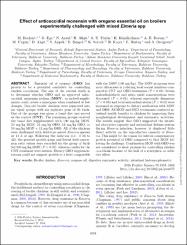Effect of anticoccidial monensin with oregano essential oil on broilers experimentally challenged with mixed Eimeria spp

Göster/
Erişim
info:eu-repo/semantics/openAccessTarih
2016Yazar
Bozkurt, MehmetEge, Göknur Bostancı
Aysul, Nuran
Akşit, Hasan
Tüzün, Ahmet Engin
Küçükyılmaz, Kamil
Borum, Ayşe Ebru
Uygun, Murat
Akşit, Dilek
Üst veri
Tüm öğe kaydını gösterÖzet
Essential oil of oregano (OEO) has proven to be a potential candidate for controlling chicken coccidiosis. The aim of the current study is to determine whether OEO and an approved anticoccidial, monensin sodium (MON), as in-feed supplements could create a synergism when combined at low dosages. Day-old broiler chickens were separated into six equal groups with six replicate pens of 36 birds. One of the groups was given a basal diet and served as the control (CNT). The remaining groups received the basal diet supplemented with 100 mg/kg MON, 50 mg/kg MON, 24 mg/kg OEO, 12 mg/kg OEO, or 50 mg/kg MON + 12 mg/kg OEO. All of the chickens were challenged with field-type mixed Eimeria species at 12 d of age. Following the infection (i.e., d 13 to 42), the greatest growth gains and lowest feed conversion ratio values were recorded for the group of birds fed 100 mg/kg MON (P < 0.05), whereas results for the CNT treatment were inferior. Dietary OEO supplementations could not support growth to a level comparable with the MON (100 mg/kg). The MON programs were more efficacious in reducing fecal oocyst numbers compared to CNT and OEO treatments (P < 0.05). Serum malondialdehyde and nitric oxide concentrations were decreased (P < 0.01), whereas superoxide dismutase (P < 0.05) and total antioxidant status (P < 0.01) were increased in response to dietary medication with MON and OEO. All MON and OEO treatments conferred intestinal health benefits to chickens by improving their morphological development and enzymatic activities. The results suggest that OEO supported the intestinal absorptive capacity and antioxidant defense system during Eimeria infection; however, it displayed little direct activity on the reproductive capacity of Eimeria. This might be the reason for inferior compensatory growth potential of OEO compared to that MON following the challenge. Combination MON with OEO was not considered to show promise for controlling chicken coccidiosis because of the lack of a synergistic or additive effect.

















